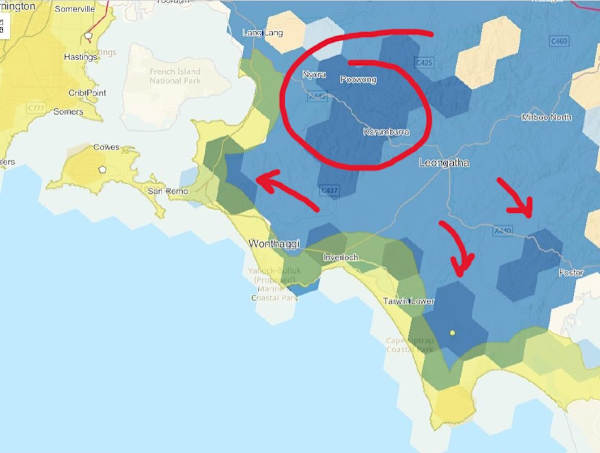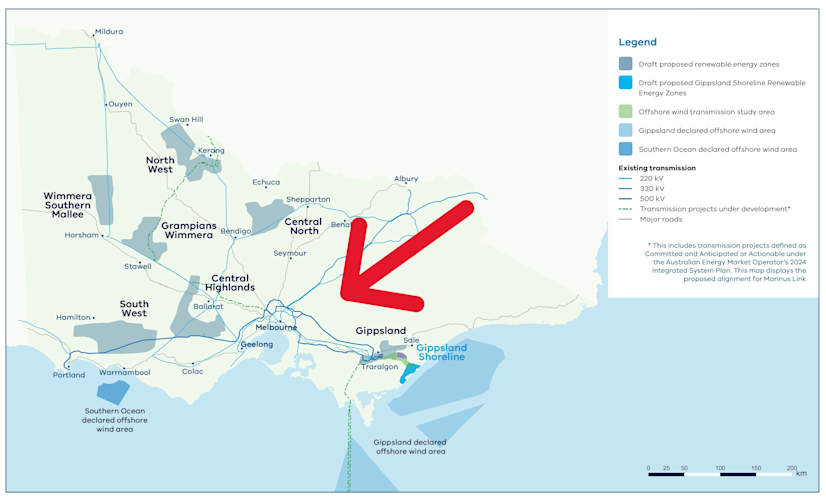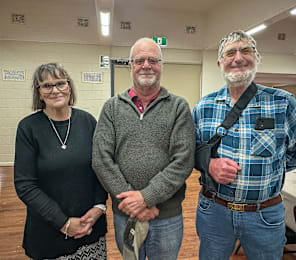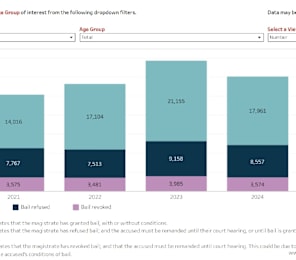THE Renewable Energy Zone (REZ) map is out and we’re not on it.
Areas of South Gippsland previously earmarked for turbine development at Korumburra and between Foster and Fish Creek, for example, have been removed.
Most of the turbines and solar farms will be in the west of the state but that doesn’t mean Gippsland is not pulling its weigh. The new VicGrid Proposed Renewable Energy Zones map also shows the off-shore wind energy zones and they’re almost all located off the coast of the South Gippsland and Wellington local government areas.
And there's a shoreline renewable energy zone to coordinate offshore wind connections in an area from McLoughlins Beach near Yarram to Seaspray near Sale.
Of course, this plan only looks at what we need in the next 15 years. All bets will be off again after that as Victoria and Melbourne in particular continue to grow.
Community-based lobby group, Responsible Renewables, has welcomed VicGrid's 2025 Victorian Transmission Plan draft, which it says confirms the Wilsons Promontory/Waratah Bay region will only see the underground Marinus Link, while "this sensitive area rightly excluded from designated Renewable Energy Zones and protected from related infrastructure".
“This decision respects what residents, visitors, and all who cherish this special region value: pristine natural environments, extraordinary biodiversity, rich cultural heritage, and spectacular land and seascapes that belong to future generations as much as our own,” said Laura Jennings, spokesperson for Responsible Renewables.
“While this brings some clarity, stronger community consultation remains essential as renewable energy expands across Victoria. Government and developers must genuinely engage with local communities to shape this transition thoughtfully. Responsible Renewables remains committed to supporting Victoria's necessary energy transition while protecting our region's unique environmental, agricultural, and tourism assets,” concluded Ms Jennings.
Here’s what VicGrid had to say when the long-awaited news on the proposed Renewable Energy Zones dropped on Friday afternoon, May 16:
VicGrid, the government body responsible for planning and developing the state’s renewable energy zones, has released the Draft 2025 Victorian Transmission Plan for community and industry feedback ahead of the release of the final plan later this year.
The Victorian Transmission Plan is necessary to keep the lights on and keep energy costs affordable as Victoria’s coal-fired power stations close.
It sets out how much more wind and solar energy Victoria is expected to need over the next 15 years and identifies the most suitable locations for new renewable energy and transmission projects. In response to significant community and industry consultation conducted in 2024, the draft plan identifies proposed areas for the renewable energy zones.
In total, less than one per cent of the state will be needed for onshore renewable infrastructure. The proposed renewable energy zones cover about 7 per cent of the state. Not all this land will host energy infrastructure.
Many of these projects will also be able to coexist with other land uses. If you’re a landholder in a renewable energy zone, you can choose whether to host new wind or solar farms on your property - it’s your decision and we encourage landholders to discuss this with their neighbours.
All proposed projects will continue to be subject to planning and environmental approval processes.
The seven proposed onshore renewable energy zones identified in the plan were chosen for their suitability to host renewable energy projects, taking into account feedback from communities, landholders, Traditional Owners, the quality of wind and solar resources, existing land uses and how projects can connect to the grid.
VicGrid has listened and learnt from the agriculture industry to ensure the draft plan minimises impacts and focuses development in areas where farming and renewable energy are believed to be more compatible. VicGrid is also working to ensure new transmission is built in the right places and at the right time to reduce the total amount of new transmission needed and keep costs as low as possible for Victorians.
We have prioritised upgrades to existing transmission lines wherever possible to minimise impacts on landholders and communities and to limit cost impacts on consumer power bills. The Victorian Transmission Plan has identified the need for four new transmission lines in addition to projects already underway.
The new projects include an additional line to support future offshore wind energy in Gippsland, a second line from South West Victoria to Melbourne, a second line between Yallourn and Hazelwood and a short line between Truganina and Deer Park in Melbourne.
Where possible, VicGrid will investigate the use of or expansion of existing easements for any new transmission lines. Landowners who host transmission will receive full and fair compensation under the Land Acquisition and Compensation Act.
The Victorian Government has also introduced an additional payment of $8,000 per km per year to recognise the important role landholders play in hosting energy infrastructure. Projects inside renewable energy zones will be required to contribute to Renewable Energy Zone Community Energy Funds, which have been subject to public consultation and will be finalised before the publication of the final Victorian Transmission Plan.
These funds will be in addition to benefits provided by individual proponents. Projects outside of a final renewable energy zone will also be required to meet standards of community engagement and benefits set out by the government and will be subject to a Grid Impact Assessment.
As part of this assessment, the project must prove it will not have a negative impact on other projects inside the zone by limiting their generation and taking up capacity on the grid. The Renewable Energy Zone Community Energy Funds will be used to improve energy supply, reliability and affordability for communities, households and businesses.
This could include things like solar panels, microgrids and cheaper energy. VicGrid will work with local councils and communities to understand their priorities for funding. The final Renewable Energy Zone Community Benefits Plan, including estimated amounts, will be published alongside the final Victorian Transmission Plan.
People can have their say on the Draft 2025 Victorian Transmission Plan at engage.vic.gov.au/vicgrid or at one of many in-person hubs and events around Victoria.
VicGrid CEO Alistair Parker has encouraged further community feedback.
“The transition to renewable energy will benefit all Victorians and boost regional economies, but it needs to be done right with long-term planning, certainty for industry, genuine consultation and real benefits for host communities, landholders and First Peoples,” said Mr Parker.
“We are changing the way energy infrastructure is planned to give communities a realsay from the beginning of the process and working closely with key industries like agriculture to ensure they continue to thrive.” “Victoria has already taken big steps in the transition to renewable energy with 40 per cent of the state’s power coming from renewables.
“Through the Victorian Transmission Plan, we can make sure we have the right infrastructure in place to keep the lights on and deliver affordable renewable power to homes and businesses as coal-fired power closes down.”
Drop-in community hubs
VicGrid has opened community hubs various n locations across Victoria including at Rosedale, Seaspray and Yarram. You can visit these centres to learn more about the draft 2025 Victorian Transmission Plan, ask questions and provide feedback in person.
You are welcome to drop in any time during opening hours. Pre-booking isn’t required.
However, if you’d like to have a one-on-one chat with a VicGrid team member, you are encouraged to book using the links HERE.
- Seaspray - Seaspray Surf Life Saving Club, 1A Foreshore Rd, Seaspray; Wednesday, May 21, 2025 & Wednesday, June 4, 2025 - 11 am to 3 pm.
- Yarram - Yarram Neighbourhood House, 292 Commercial Rd, Yarram; Wednesday, May 28, 2025 & Wednesday, June 11, 2025 - 11 am to 3 pm.











